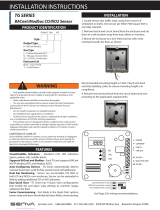
T
S
R
L2 L3 N
LOAD
TYPICAL 3Ø WIRING 120 to 600VAC
Any 0.333V CT or di-dt rogowski coil can be used
For single-phase monitoring, wire CT to Phase L1/R input.
-
+
Shield
OPERATION
Once power is applied to the unit, the OLED screen will display
the summary screen for a single load meter. To review more
system measurements, the up and down arrows will cycle
between the summary page, power readings, amperage
readings, and voltage readings.
Power Setup
To set up the meter for the correct circuit, press the enter
button to enter the Metering Menu. The connection type
3-phase ABCN or ABC and 1-phase ABN or AB must be selected
via menu, this must correspond to the wiring method used.
Wiring Cong: Press enter to choose between single circuit
or multi-circuit.
RS485 setup
The EMX is designed to easily connect to an existing
communication network. To congure the network baud
rate, protocol type, serial formats, and self-address (BACnet
only), press the enter button and scroll down to access the
Communication Menu. Here you can set the following:
1. Protocol: Press enter to choose between BACnet MS/TP or
Modbus RTU.
2. Device Address: Press or hold enter to increase address
3. Baud Rate: Press enter to choose between 9600, 19200,
38400, 57600, 76800, and 115200.
4. Parity: Press enter to choose between none, even, and odd
5. Stop Bits: Press enter to choose between 1 and 2.
Alarm Menu
If any alarm is present, a red exclamation mark will appear in
the top right corner of the OLED. At any time during normal
operation, user may scroll to the alarm menu to view active or
previous alarm conditions. See Troubleshooting section for
diagnostics.
WIRING (CONT.)
Typical Metering CT Wiring
A compatible metering CT has either a 0.333V voltage output or di/dt
signal. The wiring shown below corresponds to a Senva Metering CT
and may not represent the coloring for all compatible CTs.
Voltage Wiring
UL 240.21 code permits qualied installers to forgo use of a disconnect
device (fuses or circuit breakers) when connecting the voltage
reference of the CT, as long as the tap does not exceed 10 feet and
complies with additional guidelines regarding ampacity rating,
enclosure spacing and point of connection. It is the responsibility of
the installer to ensure the system meets the requirements of the UL
240.21 code.
If the installation does not conform with the UL 240.21 code or the
voltage reference must be extended beyond 10 feet, proper use of
over current protection is required (i.e., fusing or circuit breakers.)
In the U.S. and Canada, disconnecting fuse holders or circuit breakers
can be used. Place this device in close proximity to the CT and within
easy reach of the operator, and mark it as the disconnecting method.
The disconnect shall meet the relevant requirements of IEC 60947-1
and IEC 60947-3 and shall be suitable for the application. Provide
over-current protection and disconnecting method for supply conduc-
tors with approved current limiting devices suitable for protecting the
wiring.
Optional fuse/disconnect method.
See voltage connection note below.
L1
WARNING: To reduce the risk of electric shock, always
open or disconnect circuit from power distribution system
(or service) or building before installing or servicing current
transformers.
Current transformers are not suitable for Class 2 wiring
methods and not intended for connection to Class 2
equipment.
Field installed current transformers can be installed in panel
boards or switch gear enclosures and shall be installed
according to the following:
1. Always open or disconnect circuit from power-distribution
system (or service) of building before installing or servicing
current transformers.
2. The current transformers may not be installed in equipment
where they exceed 75 percent of the wiring space of any cross-
sectional area within the equipment.
3. Restrict installation of current transformer in an area where it
would block ventilation openings.
4. Restrict installation of current transformer in an area of
breaker arc venting.
5. Secure current transformer and route conductors so that
they do not directly contact live terminals or bus.
RS485 Ground/Shield
3X RJ11 for EMXS VERSIONS
3X +/- 0.333V for EMXT VERSIONS
RS485 (+)
RS485 ( - )
Power
Ground
PWR
GND
A(+)
B( - )
12-30VDC
24VAC
Power Supply
*Low (EMXT-L) Voltage
*Line (EMXT-H) Voltage
PWR
PWR
*Line/High (H) or Low (L) voltage inputs depend on part number selected
PH R
PH S
PH T
RS485 Ground/Shield
Pulse Input 1
Pulse Input Common
RS485 (+)
RS485 ( - )
Power
Ground
PWR
GND
COM
IN1
IN2
O1+
O1-
O2+
O2-
+
-
Pulse Input 2
Pulse Output 1+
Pulse Output 1 -
Pulse Output 2 +
Pulse Output 2 -
15-24VDC
24VAC
Phase R/L1/A Line
Phase S/L2/B Line
Phase T/L3/C Line
Neutral
*Low Voltage Input
A/L1
B/L2
C/L3
N
*Line/High (H) or Low (L) voltage inputs depend on part number selected
-
Phase R +
Phase R -
Shield
Phase S +
Phase S -
Shield
Phase T +
Phase T -
Shield
CVT Connection R/L1/A
Power Supply
CVT Connection S/L2/B
CVT Connection T/L3/C
+
S
Press any
key to wake
EMX Advanced
Energy Meter
ESC
EMX Advanced
Energy Meter
-
+
S
-
+
S
S
Pulse Input 1
Pulse Input Common
Pulse Input 2
Pulse Output 1+
Pulse Output 1 -
Pulse Output 2 +
Pulse Output 2 -
COM
IN1
IN2
O1+
O1-
O2+
O2-





